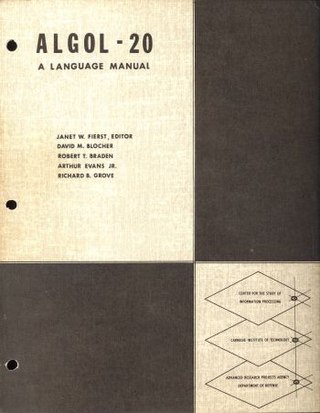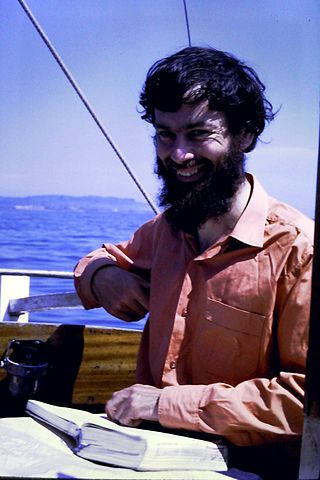
ALGOL is a family of imperative computer programming languages originally developed in 1958. ALGOL heavily influenced many other languages and was the standard method for algorithm description used by the Association for Computing Machinery (ACM) in textbooks and academic sources for more than thirty years.
In computer science, an abstract data type (ADT) is a mathematical model for data types, defined by its behavior (semantics) from the point of view of a user of the data, specifically in terms of possible values, possible operations on data of this type, and the behavior of these operations. This mathematical model contrasts with data structures, which are concrete representations of data, and are the point of view of an implementer, not a user. For example, a stack has push/pop operations that follow a Last-In-First-Out rule, and can be concretely implemented using either a list or an array. Another example is a set which stores values, without any particular order, and no repeated values. Values themselves are not retrieved from sets, rather one tests a value for membership to obtain a Boolean "in" or "not in".

A computer program is a sequence or set of instructions in a programming language for a computer to execute. It is one component of software, which also includes documentation and other intangible components.
In computer science, functional programming is a programming paradigm where programs are constructed by applying and composing functions. It is a declarative programming paradigm in which function definitions are trees of expressions that map values to other values, rather than a sequence of imperative statements which update the running state of the program.
Logic programming is a programming, database and knowledge representation paradigm based on formal logic. A logic program is a set of sentences in logical form, representing knowledge about some problem domain. Computation is performed by applying logical reasoning to that knowledge, to solve problems in the domain. Major logic programming language families include Prolog, Answer Set Programming (ASP) and Datalog. In all of these languages, rules are written in the form of clauses:
Prolog is a logic programming language that has its origins in artificial intelligence, automated theorem proving and computational linguistics.

Lua is a lightweight, high-level, multi-paradigm programming language designed primarily for embedded use in applications. Lua is cross-platform, since the interpreter of compiled bytecode is written in ANSI C, and Lua has a relatively simple C API to embed it into applications.
Poplog is a reflective, incrementally compiled software development computer programming integrated development environment and system platform for the programming languages POP-11, Common Lisp, Prolog, and Standard ML. It was created originally in the United Kingdom for teaching and research in artificial intelligence, at the University of Sussex, and later marketed as a commercial package for software development, teaching, and research. It was one of the initiatives supported for a time by the UK government-funded Alvey Programme.
In computer science, a compiler-compiler or compiler generator is a programming tool that creates a parser, interpreter, or compiler from some form of formal description of a programming language and machine.
Oz is a multiparadigm programming language, developed in the Programming Systems Lab at Université catholique de Louvain, for programming language education. It has a canonical textbook: Concepts, Techniques, and Models of Computer Programming.
POP-11 is a reflective, incrementally compiled programming language with many of the features of an interpreted language. It is the core language of the Poplog programming environment developed originally by the University of Sussex, and recently in the School of Computer Science at the University of Birmingham, which hosts the main Poplog website.
In a given programming language design, a first-class citizen is an entity which supports all the operations generally available to other entities. These operations typically include being passed as an argument, returned from a function, and assigned to a variable.
ALGOL 60 is a member of the ALGOL family of computer programming languages. It followed on from ALGOL 58 which had introduced code blocks and the begin and end pairs for delimiting them, representing a key advance in the rise of structured programming. ALGOL 60 was one of the first languages implementing function definitions. ALGOL 60 function definitions could be nested within one another, with lexical scope. It gave rise to many other languages, including CPL, PL/I, Simula, BCPL, B, Pascal, and C. Practically every computer of the era had a systems programming language based on ALGOL 60 concepts.
POP-2 is a programming language developed around 1970 from the earlier language POP-1 by Robin Popplestone and Rod Burstall at the University of Edinburgh. It drew roots from many sources: the languages Lisp and ALGOL 60, and theoretical ideas from Peter J. Landin. It used an incremental compiler, which gave it some of the flexibility of an interpreted language, including allowing new function definitions at run time and modification of function definitions while a program runs, without the overhead of an interpreted language.

Robin John Popplestone was a pioneer in the fields of machine intelligence and robotics. He is known for developing the COWSEL and POP programming languages, and for his work on Freddy II with Pat Ambler at the University of Edinburgh Artificial Intelligence laboratory.
Rodney Martineau "Rod" Burstall FRSE is a British computer scientist and one of four founders of the Laboratory for Foundations of Computer Science at the University of Edinburgh.
Freddy (1969–1971) and Freddy II (1973–1976) were experimental robots built in the Department of Machine Intelligence and Perception.
In computer programming, a function, subprogram, procedure, method, routine or subroutine is a callable unit that has a well-defined behavior and can be invoked by other software units to exhibit that behavior.




